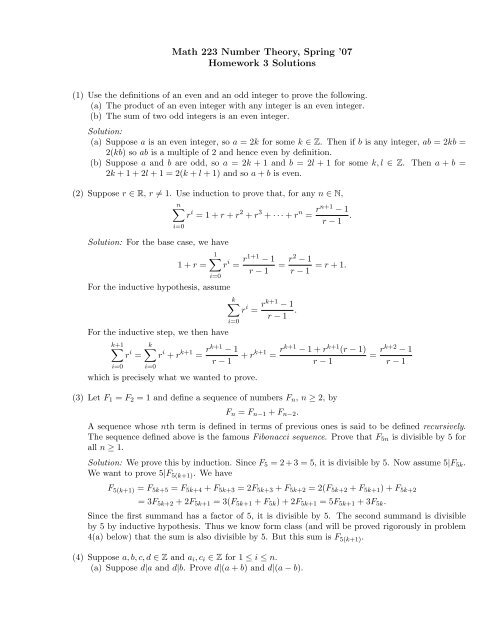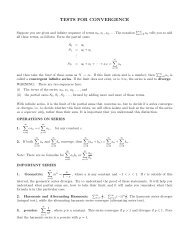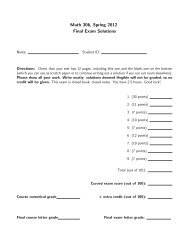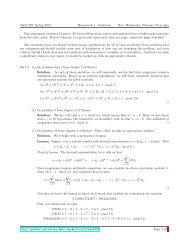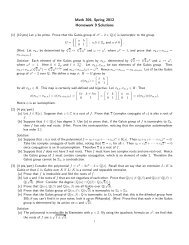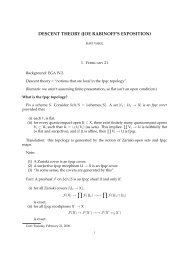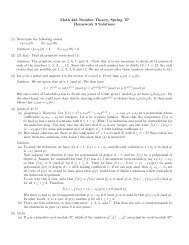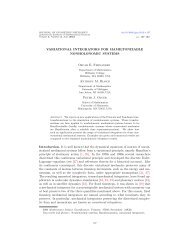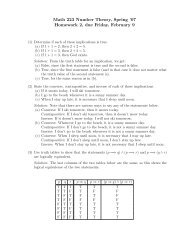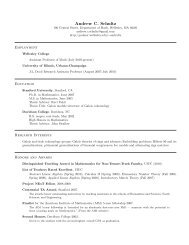Math 223 Number Theory, Spring '07 Homework 3 Solutions
Math 223 Number Theory, Spring '07 Homework 3 Solutions
Math 223 Number Theory, Spring '07 Homework 3 Solutions
- No tags were found...
You also want an ePaper? Increase the reach of your titles
YUMPU automatically turns print PDFs into web optimized ePapers that Google loves.
(b) Suppose ∀a i , d|a i . Show d| ∑ ni=1 c ia i . Explain why this generalizes part (a).Solution:(a) Since d|a and d|b, we have a = kd and b = ld for some k, l ∈ Z. Then a ± b = kd ± ld = (k ± l)dso a ± b is a multiple of d. In other words, d|(a ± b).(b) Since d|a i for all 1 ≤ i ≤ n, there exist k i ∈ Z, 1 ≤ i ≤ n, such that a i = k i d. Then(n∑ n∑n∑)c i a i = c i k i d = d c i a ii=1 i=1i=1and so ∑ ni=1 c ia i is a multiple of d. Taking n = 2, c 1 = 1 and c 2 = ±1 reduces this problem topart (a) (with a = a 1 and b = a 2 ).(5) (5.1) Use the Euclidean Algorithm to compute(a) gcd(12345, 67890)(b) gcd(54321, 9876)(It is ok to use a calculator on these problems.)Solution:(a) The Euclidean Algorithm is67890 = 5 · 12345 + 616512345 = 2 · 6165 + 156165 = 411 · 15 + 0So gcd(12345, 67890) = 15.(b) (This problem was done in class.) The Euclidean Algorithm isSo gcd(54321, 9876) = 3.54321 = 5 · 9876 + 49419876 = 1 · 4941 + 49354941 = 1 · 4935 + 64935 = 822 · 6 + 36 = 2 · 3 + 0(6) (5.4) A number l is called a common multiple of m and n if both m and n divide l. The smallestsuch l is called least common multiple of m and n and is denoted by lcm(m, n).(a) Compute(i) lcm(8, 12), (ii) lcm(20, 30), (iii) lcm(51, 68), (iv) lcm(23, 18)(b) For each of the lcm’s you computed in (a), compare the value of lcm(m, n) with the values ofm, n, and gcd(m, n). Try to find a relationship.(c) Prove that the relationship you found is correct for all integers m and n.(d) Use your result from (c) to compute lcm(301337, 307829).Solution:(a) (i) lcm(8, 12) = 24, (ii) lcm(20, 30) = 60, (iii) lcm(51, 68) = 204, (iv) lcm(23, 18) = 414(b) The relationship is(c) Let m and n have prime factorizationslcm(m, n)gcd(m, n) = mn.m = p m 11 pm 22 · · · p mrr and n = p n 11 pn 22 · · · pnr r ,
where the exponents are nonnegative integers and all primes occuring in either factorizationoccur in both, perhaps with 0 exponents. Now letMax j = max(m j , n j ) and min j = min(m j , n j ), for 1 ≤ j ≤ r.Now notice that, for any integer to be divisible by both m and n, its prime factorization has toinclude all the prime factors of both m and n. The least common multiple is thus the integerwhich contains precisely all the primes in the prime factorizations of m and n, and nothingmore. In other words,lcm(m, n) = p Max 11 p Max 22 · · · p Maxrr .On the other hand, we noticed in class thatWe then havegcd(m, n) = p min 11 p min 22 · · · p minrr .lcm(m, n)gcd(m, n) =p Max 11 p Max 22 · · · p Maxrr p min 11 p min 22 · · · p minrr=p m 1+n 11 p m 2+n 22 · · · p mr+nrr=p m 11 pm 22 · · · p mrr p n 11 pn 22 · · · pnr r= mn.(d) Using Euclidean Algorithm it is not hard to show that gcd(301337, 307829) = 541. Thus part(c) giveslcm(301337, 307829) =301337 · 307829 301337 · 307829= = 171460753.gcd(301337, 307829) 541(7) (a) Suppose m, n, s ∈ Z, m|ns, and gcd(m, n) = 1. Show that m|s.(b) Show that if m|n and n|m, then m = ±n.(c) Suppose a, b, c, d ∈ Z and gcd(a, b) = gcd(c, d) = 1. (If the greatest common divisor of twonumbers is 1, they are said to be relatively prime). Suppose that b and d are nonzero and thatab + c dis an integer. Prove that b = ±d.Solution:(a) By Linear Equation Theorem, there exist integers x and y that satisfyMultiplying this equation by s givesmx + ny = gcd(m, n) = 1.msx + nsy = s.Then m divides the first summand on the left (since it is its factor) and it divides the secondsummand since it divides ns by assumption. By problem 4(a), m then also divides s.(b) From the assumptions, we have that there exist k, l ∈ Z such that n = km and m = ln.Multiplying the two equations gives mn = klmn so kl = 1. This means either both k and l are1 or they are both −1. In the first case, we must then have m = n and in the second m = −n.(c) By assumption, a b + c d= k for some k ∈ Z. Multiplying through by bd givesThis can be rewritten in two ways:orad + cb = kbd.ad = kbd − cb and cb = kbd − adad = b(kd − c) and cb = d(kb − a).
So b|ad and d|cb. Since gcd(a, b) = gcd(c, d) = 1, b does not divide a in the first equation so itmust divide d by part (a), and d does not divide c in the second equation so it must divide b,again by part (a). So b|d and d|b and it follows that b = ±d by part (b).(8) (6.1(a)) Find an integer solution to the equation12345x + 67890y = gcd(12345, 67890).Solution: We reverse the steps of the Euclidean Algorithm performed in problem 5(a), solving forthe remainder at each stage. Let b = 12345 and a = 67890. Then we have6165 = a − 5bSo a solution is (x, y) = (11, −2).15 = b − 2 · 6165 = b − 2(a − 5b) = −2a + 11b.


